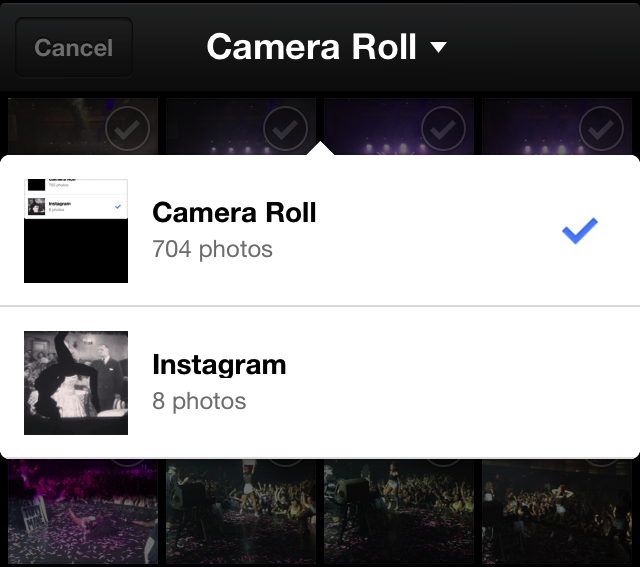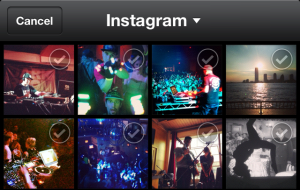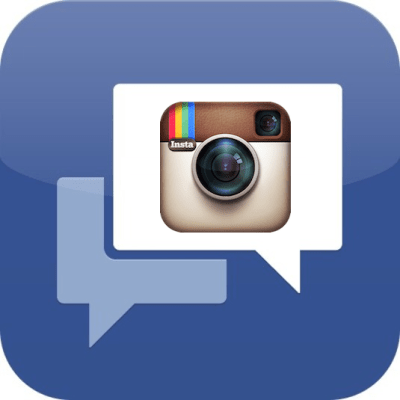Snapchat sends 200 million private photo messages a day. WhatsApp sends 325 million. These are scary numbers for Facebook that prove the visual communication is on the rise, so it’s just begun allowing Messenger for iOS users to send Instagrams and photos from other non-Camera Roll albums. It shows that while Poke failed, Facebook is serious about getting in on the visual communication trend.
You’ve been able to send photo messages from any album for a while with Messenger for Android, but the iOS version previously only let you choose from your Camera Roll. The problem is that when you post to Instagram it saves a copy of your creation to a separate in-device “Instagram” album.
Now by hitting the paperclip icon when composing a message and then Add Photos, there’s now a drop-down at the top to pull photos from your other albums. This isn’t exactly direct Instegration (sorry), though it certainly brings the photo sharing app closer to its parent company. Facebook has been remarkably hands off since acquiring Instagram, living up to its promise.
[Update: At first glance, this is a very small update. There’s not even any API or other direct connection between Messenger and Instagram. What matters is what it signals about Facebook’s intentions with visual communication. ]

But in the 16 months since the billion* dollar deal, there’s been a huge shift in how people use photos. For years they were shot with care and shared with many people — similar to what we did in the analog film era. But Snapchat and the international chat apps changed that. Suddenly photos were brazenly shot off the cuff, and shared privately not for their artistic value, but to get a message across.
This has become the year of visual communication.
The ephemerality of Snapchat’s self-destructing photos comes in handy for the most goofy, embarrassing, or scandalous. And it does add a sense of urgency. Yet an equal contributor to its rapid rise in popularity is that it forces you to communicate visually. You can’t send text alone. Instead, you use photos and videos to deliver a complex idea or emotion quickly and vividly.
In that way, photo messaging has a lot in common with stickers, the little pre-made illustrations and animations you can send in many chat apps. I get sent a lot of them and hear they’ve been a big success for Facebook. Both are a stand-in for boring text.
Photo messages are more personalized, though. Where are you? What are you doing? How do you feel? You can answer all these questions with a quick pic. It’s not annoying like typing long messages or generic like texting back “home”, “chillin” “alright”. Each location, activity, and facial expression is unique with visual communication. That’s what makes it addictive yet satisfying.
 Those two words could be Facebook’s hyphenated middle name**. Its first attempt at serious visual communication, the Snapchat clone Poke, fell fast from the charts and I haven’t received a Poke in months. But why force people to download something new when your social network runs some of the most widely used mobile apps in the world?
Those two words could be Facebook’s hyphenated middle name**. Its first attempt at serious visual communication, the Snapchat clone Poke, fell fast from the charts and I haven’t received a Poke in months. But why force people to download something new when your social network runs some of the most widely used mobile apps in the world?
And so here we are, Instagram messaging in Facebook Messenger. Expect it to get added to Facebook’s main apps soon. It could get users repurposing their favorite Instagrams to convey emotions. What are you doing? Latte art. How are you feeling? Portrait of laughter. And if enough users find the drop-down option and use it, they might even start to take Instagrams with the purpose of sharing them. It could also be a great way to make sure a specific friend sees your masterpiece if you know they don’t frequent the Instagram feed.
The question now is, will Instagram add private photo and video messaging?
*The final cash and stock acquisition price was in the seven hundred millions
**The Addictive-Satisfying Facebook
